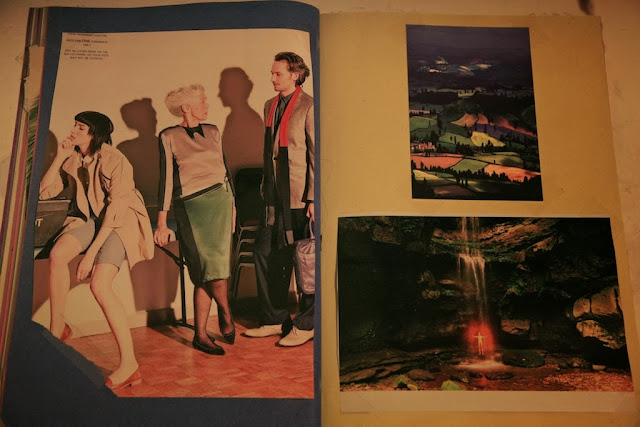In my family home I have a set of shelves at the end of my bed. They solidly bear the weight of numerous offcuts of vintage fabric, old books, art materials, notebooks, DVDs, boxes and boxes of images and scrapbooks. Bits and bobs. Anything with a bit of visual or decorative possibility. The wonky stacks suggest the potential for severe bruises if something were yanked from the bottom of a pile. Yet I can still extricate my scrapbooks. Most of them are those cheap ones with cartoon covers, usually to be found in bargain aisles. But there are several older relics with musty sugar paper and elaborate fonts.
The skin of each scrapbook may be different, but all lean towards a common purpose – the collection of unlikely images. The pages yield photos of Brigit Bardot, haphazardly sellotaped next to a sixties snapshot from an unknown wedding. The bride is wearing a dress short enough to cause embarrassment in a breeze, and appears to be either sneezing or closing her eyes happily. She and her similarly clad bridesmaid are out of place among the women surrounding them – the long coats and formal hats implying that the mother and aunts of the bride are from a quite different generation. The effect is amusing, made all the more intriguing in the juxtaposition with Bardot.
I like the label ‘scrapbook.’ It suggests the small revelry of scraps and oddments; the ability to take something as transient as a newspaper clipping and give it permanence when it’s sellotaped down next to a postcard from the National Gallery. There are pages ripped from magazines, theatre flyers, letters, leaflets, adverts and labels. A grubby train ticket can be super-imposed on a fashion shoot with a model in an orange dress. The slightly obsessive element lies in this careful process of arranging.
My method of choice is to put on music or a favourite comedy series, flood my carpet with the collected images and spend time choosing, cutting and sticking. The scrapbooks gradually thicken as Irving Penn is placed alongside a skeleton and some withered roses. This methodical process may result in a sore back, but also in an easily stored visual museum. Where else would a Gustav Klimt face off Sasha Pivarova in Vivienne Westwood? The juxtapositions can be shocking, or strangely complimentary. Decades, mixed-media and individuals become companions on a page.
A few years ago a neighbour in my village lent me three scrapbooks. They had been lovingly put together when she was young; the shapes of teddy bears and dolls meticulously cut out and gummed down. Among the archaic adverts and crayon squiggles, there were extraordinary images – a model’s head surrounded by technicolour flower petals, and photojournalism from world events that are now taught as history in secondary schools. Much like finding an inscription in the front of an old book, it felt like a privilege to catch a glimpse into a personal past, interests and memories laid out between the covers.
We keep flowers by pressing them, and a lepidopterist can preserve a rare butterfly and put it on display. However, we have become so over-loaded with visuals that images are not something to be revered or conserved any more – they are easily discarded and replaced. The first permanent photograph was taken in 1826 (with much history preceding that), and yet now every mobile phone can capture moments and events of our choosing. There are obvious advantages to this, but at the same time it seems that photography is no longer appreciated so much as a professional medium. It's harder to earn money from the profession, with fewer commissions and more vying for each job.
The skills needed to really capture personality in a portrait are hard-won. They involve not only the technical ability and eye for light, composition and colour, but also sensitivity to others’ characters and the ability to put a subject at ease. A natural, authentic photo must be caught under often artificial conditions (if it's a sitting), or unpredictable ones (if out and about). For, as Henri Cartier-Bresson once said, the role of a photographer is to “preserve life in the act of living”. If those photographers preserve life, then we in turn must preserve their photos and the legacy they bear – whether through buying books of their work or by hiding a little of the essence between the pages of a scrapbook.
The spreads from some of my scrapbooks below seemed to reflect the lazy ease of my vintage silk Laura Ashley shirt dress above - impractical (as usual) for walking but perfect to wander along a weir. Here it is worn with a vintage patent leather belt that belonged to my grandma, and a rather delicious red cardigan from a charity shop. The blue trilby is also second hand. Perhaps it's the recent relocation to a city that means I'm currently craving the sights of rural autumn.
















0 comments:
Post a Comment